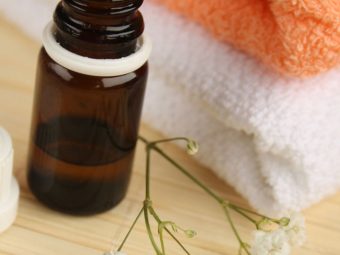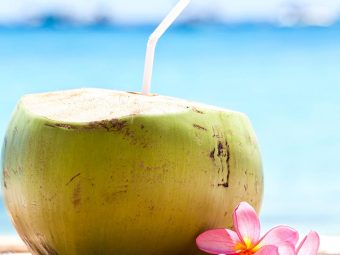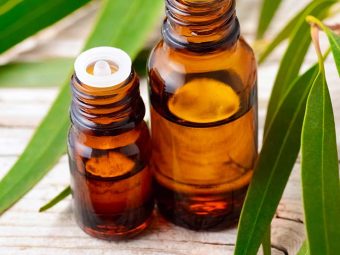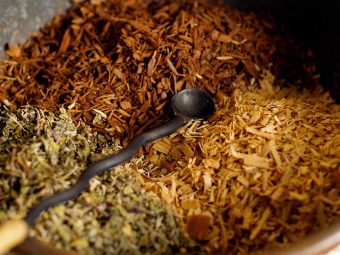31 Health Benefits Of Tea Tree Oil And Its Side Effects
Include tea tree oil in your arsenal and keep the nail and foot infections at bay.
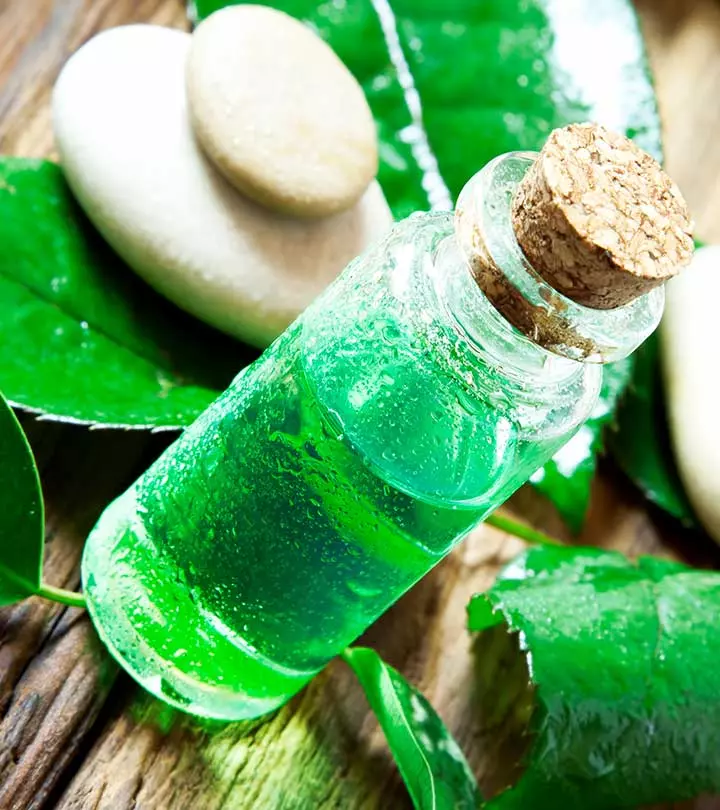
Image: Istock.com
The far-reaching benefits of tea tree oil make it one of the most widely used oils lately. But is it worth all the hype? What does science say? Luckily, the research does substantiate some of the benefits of this essential oil. Wondering what these are? Keep reading to check out the health benefits of tea tree oil, how it benefits your hair and skin, how safe it is, how to make it at home, and its potential side effects. Scroll down!
 Know Your Ingredient: Tea Tree Oil
Know Your Ingredient: Tea Tree OilWhat Is It?
Oil extracted from the leaves of the Australian Melaleuca alternifolia plant.
What Are Its Benefits?
It has antioxidant, antimicrobial, anti-inflammatory, and wound-healing properties.
Who Can Use It?
Tea tree oil can be applied topically by most people without any problems. However, it can at times irritate the skin and cause rashes.
How Often?
It can be used 2-3 times per week or even daily, depending on the treatment.
Caution
It should never be ingested. Avoid applying if you have issues like eczema or rosacea, as it might worsen the condition.
In This Article
What Are The Benefits Of Tea Tree Oil For Health?
The health benefits of tea tree oil (also called tea tree essential oil) can be attributed to its antibacterial, antimicrobial, antiseptic, antiviral, balsamic, expectorant, fungicide, insecticide, and stimulant properties. The oil treats infections, improves oral health, and even relieves root canal pain.
1. Treats Stye
A stye is nothing but an inflamed swelling at the edge of an eyelid. This could be caused by a bacterial infection. And tea tree oil, having antibacterial properties, can be a great cure for this condition. The oil cleans the stye as it reduces the inflammation and antibacterial build-up.
You can use one teaspoon of tea tree oil and two tablespoons of filtered water – mix the two and keep the mixture in the refrigerator for a while. Dilute the solution a bit and dip a clean cotton ball into it. Gently apply it around your eye at least thrice a day until the swelling and pain have gone down. Just ensure the essential oil doesn’t directly get into the eye. Tea tree oil is known to inhibit the activity of Staphylococcus bacterium (1).
2. Helps Prevent Bladder Infections
Tea tree oil is effective against the antibiotic-resistant bacteria – which is why it can work well in preventing bladder infections. The vapors of tea tree oil inhibit the bacteria (one of them being E.coli) that cause these infections. Adding ten drops of the oil to your bath water can be used as a wash for your urethra opening – which can aid in the treatment. But since there is limited research on this, it is better you consult your doctor.
As per a Polish study, tea tree oil can also aid in the treatment of urinary tract infection (2). The oil also has potential in treating urinary tract infections in premenopausal women (3)), (4).
3. Strengthens Nails

As it is a strong antiseptic, tea tree oil can fight fungal infections that might cause your nails to become brittle. It can also help treat yellow or discolored nails. You just need to mix half a teaspoon of vitamin E oil with a few drops of tea tree oil. Rub the solution on your nails and massage for a few minutes. Leave it on for 30 minutes, post which you can rinse the mixture off with lukewarm water. Pat dry and apply a moisturizing lotion. Doing this twice a month can give you the desired results.
You can also add olive, coconut, argan, and tea tree oils to a bowl. Soak your nails in the mixture for about 10 minutes. This can help rejuvenate your nails (5). Also, according to the University of Maryland Medical Center, applying undiluted tea tree oil (using a cotton swab) about 3 to 4 times a day can heal any bacterial or fungal infection (6).
4. Aids In The Treatment Of Sexually Transmitted Diseases
The antibacterial properties of tea tree oil can help relieve symptoms of sexually transmitted diseases. It can ease the pain caused by conditions like syphilisi XA sexually transmitted bacterial disease that causes painful sores, and rashes, and can damage the brain, nerves, heart, or eyes. or chancroidi XA type of sexually transmitted bacterial condition that causes painful open sores on or around the genitals. . Applying the oil to the affected area (using a clean cotton ball) can bring about great relief. Following this treatment every day for at least two weeks can show you the results. You can also add a few drops of tea tree oil to your bath water to relieve the painful symptoms.
Tea tree oil can also aid in the treatment of chlamydia, a sexually transmitted infection that is caused by the bacterium Chlamydia trachomatis. As per a study, tea tree oil has the potential to treat the infection – but further studies are required to substantiate its use (7). Do consult your doctor before you use tea tree oil for this purpose.
5. Treats Belly Button Infections
Given its antifungal and antibacterial properties, tea tree oil can be a good remedy for belly button infections. You just have to mix 4 to 5 drops of tea tree oil with 1 teaspoon of olive or coconut oil. Using a clean cotton ball, apply the oil mixture to the affected area. Leave it on for about 10 minutes, and then gently wipe the oil off the area using a clean tissue. Repeat twice to thrice a day until you see the results.
6. Heals Dry Socket Pain
Also called alveolar osteitis, dry socket is a condition where you experience intense pain a few days after having your tooth extracted. And given its antiseptic properties, tea tree oil works well to prevent tooth and gum infection and ease the pain.
Pour 1 to 2 drops of tea tree oil on a wet cotton swab (after dipping it in clean water to moisten it). Gently apply the swab against the affected area. Let it stay for 5 minutes. Remove the cotton swab and rinse the area with lukewarm water. You can do this 2 to 3 times a day or as needed.
As per a report, tea tree oil is even used in dentistry to relieve dry sockets (8).
7. May Heal Root Canal Pain
Though more research is required, the use of tea tree oil in healing root canal pain has garnered positive results. Tea tree oil was found to disinfect the root canal system (9). This may eventually help heal the pain.
8. Treats Foot Blisters
The antibacterial and astringent properties of tea tree oil can play a role in the treatment of foot blisters. In addition, the oil can cut the risk of infection and recurrence.
Take 1 part tea tree oil and mix it with 3 parts plain water (or any vegetable oil). Using a clean cotton ball, gently apply this solution to the affected area. Leave it on for about 10 minutes, post which you can gently rinse with cold water. You can repeat this twice to thrice in a day for a few days.
You can also add a few drops of tea tree oil to clean warm water and soak your feet in it for about 10 minutes. It can work like a charm. Just ensure that the tea tree oil you use is pure. And since it is potent, you should use it sparingly (10). Avoid direct contact with the eyes.
9. Treats Ear Infections
This again boils down to the antifungal and antibacterial properties of tea tree oil. You can dilute a few drops of tea tree oil with one-fourth cup of olive oil before using it. Dip a cotton ball into the mixture. Tilt your head to one side, and rub the cotton ball into your ear. Tea tree oil should not be directly added to the ear canal, so please be careful with the application.
You can also mix tea tree oil with coconut oil. Just rub the mixture around the ear.
Another study speaks about the high amounts of terpinen-4-ol in tea tree oil (11). This is a major component of tea tree oil and is known to kill the bacteria it comes in contact with. This could be another reason tea tree oil is more effective than most antibacterial agents.
However, certain studies suggest that applying tea tree oil on the ear can cause some undesirable effects. The oill might be toxic to the ears to some extent, especially if used in extremely high contentrations (12). Do consult your doctor before use.
10. Treats Vaginal Odor
As per anecdotal evidence, tea tree oil can help eliminate vaginal odor. The natural antifungal and antimicrobial properties of the oil help achieve this. You just have to mix a few drops of tea tree oil with water. Apply a drop or two to the outer area of your vagina. You can repeat this for 3 to 5 days, and if the symptoms don’t improve (or worsen), discontinue use and talk to your doctor.
You can also mix a few drops of tea tree oil with water and witch hazel and add them to a cotton pad. Apply the pad to the affected area. But make sure you dilute tea tree oil with the water and witch hazel – as the oil can cause some sensitivity in your groin area.
11. Might Help Combat Pneumonia
As per a Chinese study, inhaling tea tree oil might help ease symptoms of pneumonia (13). Though this shows that the oil has great applications in the field of medicine, we still don’t know if you can use it the same way at home for relieving the symptoms. But do consult your doctor once.
 Trivia
Trivia12. Helps Treat Cellulitis
In one study, usage of tea tree oil was found to accelerate wound healing in abscesses and cellulitisi XA common bacterial skin infection where the affected skin becomes red and tender causing pain and inflammation. (14). And this can be attributed to the antifungal, antibacterial, and anti-inflammatory properties of the oil.
You simply have to moisten a cotton swab with water and add a couple of drops of tea tree oil. Dab the swab on the infected area. Let the oil stay for a few hours, post which you can wash it off with cold water.
You can also mix a couple of drops of tea tree oil in one teaspoon of raw honey or aloe vera gel. Apply to your skin using a cotton swab and rinse after a few hours.
13. Cures Oral Thrush
Tea tree oil can act against the Candida albicans yeast that is known to cause oral thrush (15). According to another study, using tea tree oil gel twice on a toothbrush (as a dentifrice) can reduce gingivitisi XA common gum disease that occurs when plaque and bacteria build up in the mouth affecting the gingiva. inflammation (16).
Tea tree oil can also heal receding gums (in addition to periodontal diseasei XA dental condition that is mainly the result of infections and inflammation of the gums and bone that surround and support the teeth. and oral herpes infections). Experts say that it is best to use tea tree oil as a gel when it comes to treating dental ailments. You can also use a mouth rinse containing a 5 percent dilution of tea tree oil – rinse with 1 tablespoon of the solution about four times a day. Also, ask your dentist about the concentration of the oil in the solution.
Most importantly, never swallow tea tree oil in any form.
14. Treats Blepharitis
Blepharitis is a condition where the eyelid is inflamed. According to the American Academy of Ophthalmology, the antimicrobial and anti-inflammatory effects of tea tree oil might help heal the condition (17).
Blepharitis could be caused by dust mites that enter the eye, which go on to mate, causing inflammation. Since the eyelids are less accessible to thorough cleaning, it is hard to clean the mites off and not let them mate. However, tea tree oil can help. According to a UK study, the anti-inflammatory and antibacterial effects of tea tree oil can help treat blepharitis (18). You can also scrub your eyelids with 50 percent tea tree oil, which you can get from the nearest pharmacy (19).
A study compared the blepharitis treatment with tea tree oil and another or no treatment in a randomized controlled trial with 562 participants from the US, Australia, Ireland, China, Korea, and Turkey. Out of these, 160 participants who received tea tree oil treatment and scrubbed their eyelids per week saw a reduced count of mites in their eyes. Another 335 participants saw long and short terms relief after using tea tree oil.
15. Treats Swollen Lymph Nodes

Also called lymphadenitis, where your lymph nodes feel tender and swollen (and even painful) when touched. This is usually a sign of a bacterial infection somewhere in the body. Applying tea tree oil can have an immediate effect, and then a slow-release effect in the next 24 hours.
You can either inhale the oil directly from the bottle or apply it to the affected area. And as already discussed, the oil is not for consumption. Also, when using on the skin, apply only a few drops of the oil (after diluting it with an equal amount of coconut oil).
Applying a tea tree oil compress to the affected area can also ease the pain and other related symptoms. Just add 1 to 2 drops of the oil to the compress and apply it to the area. Do this for 10 to 15 minutes a few times daily.
16. Reduces Body Odor
The antibacterial properties of tea tree oil can help control underarm odor or body odor related to perspiration. It is important to know that sweat itself doesn’t smell. It is only when the secretions combine with the bacteria on the skin does it smell. Tea tree oil can be a good (and possibly healthy) alternative to commercial deodorants and other antiperspirants.
Here’s one natural deodorant you can prepare using tea tree oil. All you need are 3 tablespoons each of shea butter and coconut oil, ¼ cup each of cornstarch and baking soda, and 20 to 30 drops of tea tree oil.
Melt the shea butter and coconut oil in a glass jar (you can place the jar in boiling water). Once they have melted, remove the jar from the heat and stir in the remaining ingredients (cornstarch, baking soda, and tea tree oil). You can pour the mixture into a jar or a small container or an old deodorant stick. Or best, pouring it into mini-silicone muffin tins can help form the mold easily. Wait for several hours for the mixture to set. You can then rub the mixture like a lotion on your underarms using your fingers.
17. Cures Bad Breath
Tea tree oil is believed to be a wonderful cure for bad breath, given its antibacterial properties. You can simply add a drop of the oil to your toothpaste before you brush your teeth.
You can also make a tea tree oil mouthwash by adding 3 drops of the oil to a cup of warm water. Just gargle this solution twice to thrice a day, preferably after a meal. But yes, never swallow the solution. And yes, since there is limited research on this, do consult your doctor or dentist once.
What About The Benefits For Skin?
Tea tree oil has wonderful benefits for your skin. Its anti-inflammatory and antibacterial properties help you get rid of acne and make your skin clearer and brighter. The oil can even help you get rid of scars and marks. You can also use a tea tree oil bath (adding 6 drops of the oil to your bath) for regular skin rejuvenation.
18. Helps Treat Acne And Other Skin Issues
Most anti-acne creams contain tea tree extracts – and they do so for a reason. As per certain studies, tea tree oil is as effective as benzoyl peroxide when it comes to fighting acne. The oil also reduces the sebum production by the skin.
Mix 2 to 3 drops of tea tree oil with 1 tablespoon each of honey and yogurt. Apply this mixture on your acne. Leave it on for about 20 minutes, after which you can wash your face. Repeat daily. Certain sources say that tea tree oil with coconut oil can also help relieve acne.
Even if you are suffering from dark spots or a pimple outburst, tea tree oil can come to your rescue. Just dab a few drops of the oil on a cotton swab and gently apply to the affected areas. Leave it on for 10 minutes and then rinse. You can also use gels and face washes containing tea tree oil. This tea tree oil remedy can also be used to remove dark spots on legs.
Tea tree oil can also work well for skin whitening. You just need to combine 1 teaspoon of jojoba oil with 4 drops of tea tree oil. Blend one tomato in a mixer and add these mashed tomatoes to the oil mixture. Apply the mask to your face and leave it on for 10 minutes. Rinse with lukewarm water and pat dry. This mask also helps remove sun tan. And worry not – tea tree oil will not bleach your skin.
For dry skin, you can combine 5 drops of tea tree oil with 1 tablespoon of almond oil. Massage it gently into your skin and leave it on. Bathe normally and wash your face as usual. Regular use of this face mask can keep your skin hydrated for longer periods.
You can also make a homemade honey face wash for clean skin using tea tree oil. You just need 1/3 cup of tea tree castile soap, another 1/3 cup of honey, 3 tablespoons of distilled water, 2 tablespoons of skin-nourishing oil (like that of jojoba or almond), and some water. Add the water in a soap dispenser and then the other ingredients. Shake well until the honey mixes well. Your face wash is ready to use – just shake the soap dispenser before every use. This face wash has great benefits – it enriches your skin and makes it smoother.
Tea tree oil may reduce under-eye dark circles. It can also treat under eye bags. But since the skin around the eyes is delicate and subtle, we aren’t sure how far this is true. Talk to your doctor before using the oil for this purpose.
19. Cures Ringworm
Being antifungal, tea tree oil can be an effective treatment for ringworm.
You need to first thoroughly cleanse and dry the area affected by ringworm. Also, any cloth you have used to dry the affected area must be dumped into the washing machine – to avoid contamination. Add several drops of tea tree oil to the end of a sterile cotton swab. Apply the swab directly to all the affected areas. Repeat this process thrice a day. You can dilute the oil if you find it irritating your skin. You can also use a sterile cotton ball if you have a large area to cover.
20. Fights Psoriasis
Adding a few drops of tea tree oil to your bath can help improve the condition.
21. Treats Eczema
Simply mix 1 teaspoon of coconut oil and 5 drops each of lavender and tea tree oils to make a tea tree oil eczema lotion. Apply on the affected area before you take a bath.
22. Heals Cuts And Infections
The oil is known to heal cuts and infections naturally. Other infections like insect bites, rashes, and burns can also be cured with the oil – it works as an antiseptic. Just add a few drops of the oil to your bath water.
23. Gives Relief From Razor Burns
Razor burns can be particularly uncomfortable and unsightly. And the wrong treatment can only make them worse. But with tea tree oil, curing them is quite simple. After shaving, just pour a few drops of the oil on a cotton swab and apply to the infected areas. This will soothe your skin and heal the burns faster.
You can also use the oil as an after-wax wash. And a tea tree oil soap (which you can get in the market) can be used as a shaving lather. This tea tree oil has benefits similar to the oil – and when it comes to skin issues, it could be a more convenient option.
24. Treats Nail Fungus
Applying tea tree oil to the infected nail can help relieve nail fungus symptoms. Its antifungal properties play a role here. Apply the oil using a cotton swab to your infected nail. Do this twice to thrice a day. This remedy can be used to treat toe fungus as well.
But again, there is limited research on this. Please consult your doctor.
25. Treats Athlete’s Foot
Medically known as tinea pedis, this is a contagious fungal infection on the feet that might spread to the toenails and hands. Some of the symptoms can include blisters, redness, cracking, and peeling.
Studies suggest that tea tree oil can be an effective treatment for athlete’s foot (20).
You can simply combine ¼ cup each of arrowroot powder and baking soda with 20 to 25 drops of tea tree oil. Stir and store in a covered container. Apply the mixture to clean and dry feet twice a day.
26. Helps Remove Makeup
Simply mix ¼ cup of canola oil with 10 drops of tea tree oil and transfer the mixture to a sterilized glass jar. Cap it tight and shake until the oils are blended well. Store the jar in a cool and dark place. For using it, dab a cotton ball into the oil and sweep it over your face. This helps remove makeup easily. Post this, you can rinse thoroughly with warm water and follow with a toner.
27. Soothes Boils
Boils most often occur due to infections that affect the hair follicles on your skin surface (21). They can cause inflammation and even fever. The blood cells try to combat the infection, and in the process, the boils get bigger and tender. And more painful. You can surely have them treated by a doctor – but using tea tree oil can be extra helpful. Simply apply the oil with a clean cotton ball on the affected area. Ensure the application is gentle. Regular application can soothe the boils.
28. Treats Warts
The antiviral properties of tea tree oil can help combat the virus that causes warts. Just wash and dry the area around the wart. Apply just one drop of pure and undiluted tea tree oil over the wart and put a bandage over the area. You can also apply the oil to the head of the bandage if you think that’s easier. Leave the bandage on for about 8 hours (or overnight). The next morning, remove the bandage and wash the area with cold water. You can either put another bandage only in the night or put one right away (with tea tree oil applied).
Just repeat the process every day until the wart disappears of or falls off. This can take anywhere between 1 to 4 weeks.
Tea tree oil also works well for genital warts. You just have to apply a drop of the diluted oil directly to the wart. But just to test if you are allergic to the oil, apply a small amount on your forearm first. If you develop no undesirable reaction, you are good to go.
29. Soothes Chicken Pox Symptoms
Chicken pox can cause severe itching and even provoke the individual to scratch his/her skin, leading to scars. To soothe this itching, one can take a bath with warm water mixed with tea tree oil.
Just add about 20 drops of tea tree oil to your bathtub or bucket filled with water. You can either soak yourself or take a bath with the water. Alternately, you can also apply clean cotton balls soaked in the oil to the affected areas of your skin.
For Hair?
Tea tree oil works wonders for your hair. The antibacterial and antifungal properties of the oil fight any kind of scalp infections, which can contribute to hair loss and other issues.
30. Makes Hair Longer And Thicker
Using tea tree oil is a simple and effective way to maintain hair health. You can either massage the oil into your scalp or even mix it with your shampoo.
Adding a few drops of the oil to your regular shampoo can enhance the latter’s therapeutic properties.
For longer and thicker hair (or basically, for proper hair growth), you can mix a few drops of tea tree oil with an equal amount of carrier oil (like that of almond of coconut). Mix well and massage into the scalp. Rinse thoroughly. The mixture will feel refreshing and can also leave a tingling sensation on your scalp.
You can also mix tea tree oil with olive oil to make your hair soft and smooth. This also forms a protective layer on your hair that boosts hair growth – a probable treatment for hair loss.
31. Helps Fight Dandruff And Itchiness
Using the oil after mixing with your regular shampoo can also help treat dandruff and the accompanying itchiness. You can also use the oil to treat dry scalp. Mix the oil with a carrier oil and gently massage into your scalp for about 15 minutes. Wash your hair thoroughly (after leaving the oil blend on for about 10 minutes). Tea tree oil moisturizes your scalp and treats dry scalp.
You can use the oil for removing lice too. Apply a few drops of tea tree oil on your scalp and leave it on overnight. The next morning, comb through the hair to remove the dead lice. Wash your hair with a shampoo and conditioner containing tea tree oil.
While we conclude the long list of benefits of tea tree oil with that, one also needs to understand how it actually works.
How Does Tea Tree Oil Actually Work?
Tea tree oil is an essential oil that has a fresh camphoraceous odor and color that ranges from pale yellow to clear. Taken from the leaves of the Melaleuca alternifolia, which is native to Southeast and Northeast Australia, the oil is a member of the Myrtaceae family. It is a small tree that grows up to a height of about 7 meters – it has small needle-like leaves, paper-like bark, and purple or white flowers.
What makes the oil work is, for obvious reasons, its composition. Though the oil is made up of over a 100 components, its major constituents include terpene hydrocarbons – monoterpenes, sesquiterpenes, and their respective alcohols. Terpinen-4-ol is a major component, as we already saw. Another component called 1,8-cineole could be responsible for the adverse reactions tea tree oil might cause.
And now…
Let Us Know About Its History
The name of the oil is thought to have originated from Captain James Cook’s description of one of the shrubs that he had used to make an infusion to drink instead of tea.
Commercially, the tea tree oil industry originated in the 1920s when an Australian by the name of Arthur Penfold investigated the business potential of several native extracted oils. He reported that tea tree oil held great promise given its potent antiseptic properties. And in the 1970s and 1980s, commercial plantations began to produce large quantities of the oil.
All good. But what has research been saying all along? Anything different from the benefits?
Is Tea Tree Oil Safe?
Topically, it is safe (almost always). But taking it orally may cause some serious symptoms (22). According to Dr. Scott A. Johnson, one should limit ingestion of tea tree oil to reasonable amounts and avoid giving it to children under 6 years of age.
How To Make Tea Tree Oil
You can make tea tree oil right in your kitchen. All you need is a bunch of fresh tea tree leaves.
- Add the leaves to a pot and cover them with water. Place a vegetable steamer in pot, over the leaves and water.
- Put a measuring cup inside this steamer.
- Place a lid on the pot (upside down). Ensure the handle nub of the lid is pointing towards the measuring cup.
- Boil the water to steam the leaves. The water will first condense and evaporate. This condensation will slide towards the handle and into the measuring cup.
- Add four ice cubes on top of the overturned lid. This hastens the condensation of the steam.
- Once the ice has melted, turn off the heat.
- Remove the lid and pour the ice cube water into the sink. Remove the glass measuring cup.
- Pour of the contents of the measuring cup into a separating funnel (ensure the stopcock at the bottom of the funnel is closed). Close the top of the funnel and shake it vigorously.
- Invert the funnel and open it to release the pressure. This makes the oil float to the top of the water (as the two substances get separated).
- Position a glass bottle beneath the stopcock and release the water. You can pour the oil into a tinted glass bottle.
- Keep repeating the process (up to three more times) to extract more oil from the leaves.
And guess what? You can even have a homemade tea tree oil household cleaner. You just need ½ cup of white vinegar, 3 cups of water, and ¼ teaspoon of tea tree oil.
In a spray bottle, combine all the ingredients and shake well. You can then add a few drops of your favorite essential oil to this mix. Just use this cleaner like any other – on hard surfaces like counter tops, floors, sink surfaces, etc.
And well…
Any Other Uses Of Tea Tree Oil?
You can also use tea tree oil both aromatically and topically. Of course, we did see most of the uses already.
You can diffuse tea tree oil throughout your home with an oil diffuser. You can also spray some of the oil on your clothes or skin, just like a perfume.
And while using it topically, ensure you always dilute tea tree oil with a carrier oil (like coconut oil) in a 1:1 ratio. Do this before you apply the oil to the skin.
In case you are wondering where to purchase the oil…
Where To Buy Tea Tree Oil
You can buy tea tree oil from your nearest supermarket. If you want to purchase it online, However, since a recent report discovered that about half of commercially available tea tree oils were not genuine and authentic it is important to vet the oil by reviewing its composition before purchase (23).
Another internationally famous tea tree oil brand is Jason Tea Tree Oil, which you can buy here.
And now, we head to some fun facts…
Any Facts?
- Though tea tree oil can be used just about anywhere on the body, it is particularly effective neck up.
- Tea tree oil very easily blends with many essential oils.
- During the World War II, anybody who produced tea tree oil as a profession was excluded from the draft.
 Did You Know?
Did You Know?We saw all good and rosy about tea tree oil until now. But as we mentioned, the oil has some side effects too.
Cautions
The oil is toxic when taken orally. And when applied topically, though safe to large extent, it can cause complications in some people.
- Skin Issues
Tea tree oil can cause skin irritation and swelling in some people. In people affected with acne, the oil can sometimes cause dryness and itching and burning.
- Hormonal Imbalances
Using tea tree oil on the skin of young boys who haven’t yet reached puberty may cause hormonal imbalances. The oil may result in the boys developing breast growth (24).
- Issues With Gargling
Take care while gargling with tea tree oil as in some cases, the potent substances in the oil were found to injure the hypersensitive membranes in the throat. Consult your doctor.
Tea tree oil is likely safe for pregnant and breastfeeding women when used topically. But talking about oral consumption, it’s a big no.
Dosage
The dosage depends on the concentration of tea tree oil and the severity of the condition it is being used for.
- Mouthwash: Add three drops of tea tree oil to less than half a glass of water and use it as a mouthwash (25). However, remember not to swallow it as it is toxic when ingested.
- Acne Treatment: Application of 5% tea tree oil solution is shown to be effective in the treatment of mild to moderate acne vulgaris (26).
- Vaginal Infections: Using tea tree oil suppositories containing 200 mg of this essential oil in a vegetable base may help treat several vaginal infections (27).
Infographic: Aromatherapy With Tea Tree Oil
One of the best ways to attain the many benefits of tea tree oil for your health, skin, and hair is through aromatherapy. Depending on your preference, you can use tea tree oil by itself or blend it with other essential oils or carrier oils.
Check out the infographic below to learn how to make the most of an aromatherapy session with tea tree oil. Illustration: StyleCraze Design Team
The benefits of tea tree oil are many. It is a natural remedy that can help treat a stye and manage infections of the bladder, belly button, and ear. It also strengthens nails, heals dry socket pain, manages foot blisters, and helps reduce acne, eczema, and psoriasis. However, caution is advised for people with skin issues and hormonal imbalances. But if you are not allergic to tea tree oil and don’t have any of the above-listed complications, you can use it regularly to reap its benefits.
Frequently Asked Questions
How long can you leave tea tree oil on your skin?
About 15 to 20 minutes would do.
What should I do if I ingest tea tree oil?
Head to the nearest clinic immediately.
Can tea tree oil be used for wrinkles?
Yes. A mixture of avocado, honey, and a few drops of tea tree oil can serve as an anti-wrinkle face mask. Apply the mixture on your face and neck, and wash after 20 minutes. Do this daily.
Is tea tree oil good for oily hair?
Yes. You can apply it to oily hair.
What about tea tree oil for nipple piercings?
It can help soothe the process. But there is limited research. Talk to the concerned person for better advice.
Does tea tree oil lighten skin?
There is a lack of evidence suggesting that tea tree oil lightens skin.
Is tea tree oil good for your armpits?
Possibly. Tea tree oil has astringent and antibacterial properties that may act as a natural deodorant and keep foul body odor away.
Can I add tea tree oil to my moisturizer?
Yes, add a few drops of this essential oil to your moisturizer to benefit from its antibacterial, antifungal, and stimulant properties.
Does tea tree oil grow eyelashes?
Possibly. Dilute tea tree oil in carrier oil and dab a few drops on your lashes to boost their growth.
Key Takeaways
- It may help strengthen nails as it has antifungal properties which prevent nails from yellowing and becoming brittle.
- It may prevent ear infections as it has antifungal and antibacterial properties.
- Tea tree oil may also make your hair longer and thicker, combat dandruff, and remove lice.
- However, it may cause hormone imbalance in boys who haven’t reached puberty yet by developing causing breast growth.

Image: Stable Diffusion/StyleCraze Design Team
The benefits of tea tree oil are plenty. Check out the video below to learn how this wonder oil can improve your hair, skin, and overall health!
References
Articles on StyleCraze are backed by verified information from peer-reviewed and academic research papers, reputed organizations, research institutions, and medical associations to ensure accuracy and relevance. Read our editorial policy to learn more.
- “Can natural medicine cure a stye?“. Dailymail.
- “Evaluation of the effectiveness of tea tree oil in treatment of Acanthamoeba infection“. Poznan University of Medical Sciences, Poland.
- “An overview on urinary tract infections and…”. Journal of Medicinal Plants Studies.
- “How women manage recurrent urinary tract infections”. BMC Family Practice, US National Library of Medicine.
- “TOP TIPS FOR STRONG SUMMER NAILS“. Health and Style Institute.
- “Nail disorders“. University of Maryland Medical Center.
- “Vaginal discharge“. Maryhill Health Centre, Glasgow.
- “Melaleuca quinquenervia (Cav.)“. Purdue Agriculture.
- “Natural medicaments in dentistry“. Kothiwal Dental College Research Centre and Hospital, Uttar Pradesh, India. 2014 June.
- “FIRST AID FOR THE GARDENER’S SKIN“. University of Vermont Extension Department of Plant and Soil Science.
- “Melaleuca alternifolia (Tea Tree) Oil: a Review of Antimicrobial and Other Medicinal Properties“. The University of Western Australia, , Crawley, Western Australia.
- “A study of tea tree oil ototoxicity“. University of Western Australia, Nedlands, Australia.
- “Tea tree oil nanoemulsions for inhalation…”. Colloids and Surfaces. B, Biointerfaces, US National Library of Medicine.
- “Commercial Essential Oils as Potential Antimicrobials to Treat Skin Diseases“. University of the Witwatersrand, South Africa.
- “The wonders of Tea Tree oil“. DailyMail.
- “Effect of local application of tea tree (Melaleuca alternifolia) oil gel on…“. Tanta University, Tanta, Egypt. 2013 August.
- “Managing Blepharitis: Tried-and-True and New Approaches“. American Academy of Opthalmology. 2012 July.
- “Blepharitis: remains a diagnostic enigma. A role for tea tree oil shampoo?“. University of Southampton, Southampton, UK. 2015 December.
- “Blepharitis“. MayoClinic.
- “Tea tree oil in the treatment of tinea pedis”. The Australian Journal of Dermatology, US National Library of Medicine.
- “Folliculitis”. MayoClinic.
- “Tea tree oil”. National Center for Complementary and Integrative Health.
- “New bulletin provides review on…”. American Botanical Council.
- “Lavender and tea tree oils may cause…”. National Institutes of Health.
- “Tea Tree Oil versus Chlorhexidine Mouthwash in Treatment of Gingivitis: A Pilot Randomized, Double Blinded Clinical Trial”. National Institutes of Health.
- “The efficacy of 5% topical tea tree oil gel in mild to moderate acne vulgaris: a randomized, double-blind placebo-controlled study”. National Institutes of Health.
- “Tea Tree Oil and Vaginal Infections”.


















